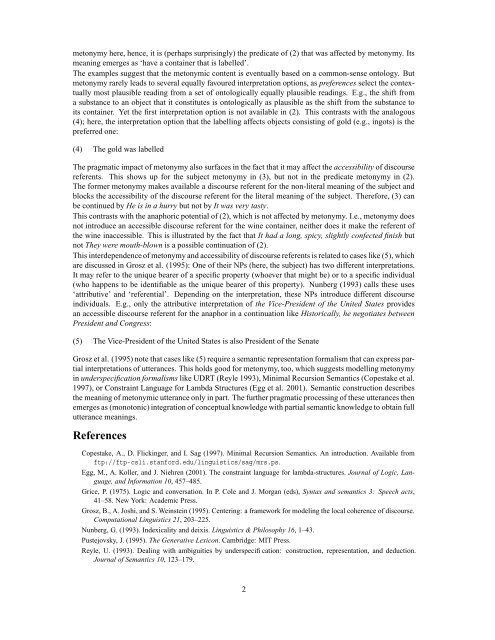SemPrag03.Progr.pdf - Institut für Linguistik/Germanistik - Universität ...
SemPrag03.Progr.pdf - Institut für Linguistik/Germanistik - Universität ...
SemPrag03.Progr.pdf - Institut für Linguistik/Germanistik - Universität ...
Create successful ePaper yourself
Turn your PDF publications into a flip-book with our unique Google optimized e-Paper software.
metonymy here, hence, it is (perhaps surprisingly) the predicate of (2) that was affected by metonymy. Its<br />
meaning emerges as ‘have a container that is labelled’.<br />
The examples suggest that the metonymic content is eventually based on a common-sense ontology. But<br />
metonymy rarely leads to several equally favoured interpretation options, as preferences select the contextually<br />
most plausible reading from a set of ontologically equally plausible readings. E.g., the shift from<br />
a substance to an object that it constitutes is ontologically as plausible as the shift from the substance to<br />
its container. Yet the first interpretation option is not available in (2). This contrasts with the analogous<br />
(4); here, the interpretation option that the labelling affects objects consisting of gold (e.g., ingots) is the<br />
preferred one:<br />
(4) The gold was labelled<br />
The pragmatic impact of metonymy also surfaces in the fact that it may affect the accessibility of discourse<br />
referents. This shows up for the subject metonymy in (3), but not in the predicate metonymy in (2).<br />
The former metonymy makes available a discourse referent for the non-literal meaning of the subject and<br />
blocks the accessibility of the discourse referent for the literal meaning of the subject. Therefore, (3) can<br />
be continued by He is in a hurry but not by It was very tasty.<br />
This contrasts with the anaphoric potential of (2), which is not affected by metonymy. I.e., metonymy does<br />
not introduce an accessible discourse referent for the wine container, neither does it make the referent of<br />
the wine inaccessible. This is illustrated by the fact that It had a long, spicy, slightly confected finish but<br />
not They were mouth-blown is a possible continuation of (2).<br />
This interdependence of metonymy and accessibility of discourse referents is related to cases like (5), which<br />
are discussed in Grosz et al. (1995): One of their NPs (here, the subject) has two different interpretations.<br />
It may refer to the unique bearer of a specific property (whoever that might be) or to a specific individual<br />
(who happens to be identifiable as the unique bearer of this property). Nunberg (1993) calls these uses<br />
‘attributive’ and ‘referential’. Depending on the interpretation, these NPs introduce different discourse<br />
individuals. E.g., only the attributive interpretation of the Vice-President of the United States provides<br />
an accessible discourse referent for the anaphor in a continuation like Historically, he negotiates between<br />
President and Congress:<br />
(5) The Vice-President of the United States is also President of the Senate<br />
Grosz et al. (1995) note that cases like (5) require a semantic representation formalism that can express partial<br />
interpretations of utterances. This holds good for metonymy, too, which suggests modelling metonymy<br />
in underspecification formalisms like UDRT (Reyle 1993), Minimal Recursion Semantics (Copestake et al.<br />
1997), or Constraint Language for Lambda Structures (Egg et al. 2001). Semantic construction describes<br />
the meaning of metonymic utterance only in part. The further pragmatic processing of these utterances then<br />
emerges as (monotonic) integration of conceptual knowledge with partial semantic knowledge to obtain full<br />
utterance meanings.<br />
References<br />
Copestake, A., D. Flickinger, and I. Sag (1997). Minimal Recursion Semantics. An introduction. Available from<br />
ftp://ftp-csli.stanford.edu/linguistics/sag/mrs.ps.<br />
Egg, M., A. Koller, and J. Niehren (2001). The constraint language for lambda-structures. Journal of Logic, Language,<br />
and Information 10, 457–485.<br />
Grice, P. (1975). Logic and conversation. In P. Cole and J. Morgan (eds), Syntax and semantics 3: Speech acts,<br />
41–58. New York: Academic Press.<br />
Grosz, B., A. Joshi, and S. Weinstein (1995). Centering: a framework for modeling the local coherence of discourse.<br />
Computational Linguistics 21, 203–225.<br />
Nunberg, G. (1993). Indexicality and deixis. Linguistics & Philosophy 16, 1–43.<br />
Pustejovsky, J. (1995). The Generative Lexicon. Cambridge: MIT Press.<br />
Reyle, U. (1993). Dealing with ambiguities by underspecification: construction, representation, and deduction.<br />
Journal of Semantics 10, 123–179.<br />
2

















